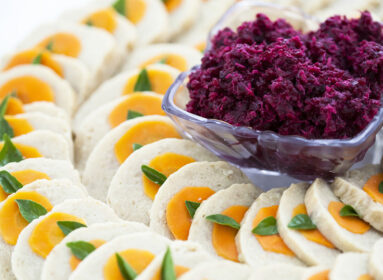By Cindy Mindell
FAIRFIELD – Prof. David Kraemer, author of “Jewish Eating and Identity through the Ages” (Routledge, 2007), will discuss his research into the history of Jewish eating practices from the Torah to the 21st century at Fairfield University on Thursday, Oct. 5 as part of the university’s Bennett Center for Judaic Studies’ 2010 Judaic Studies Scholar-in-Residence Program.
The book is the first ever to explore its subject. The Joseph J. and Dora Abbell Librarian and Professor of Talmud and Rabbinics at the Jewish Theological Seminary in New York City, Kraemer says the book is a combination of two passions. “I love studying Jewish texts and I happen to be the cook in my household and love food,” he says. “I was looking for a history of kashrut, and there was no such thing. I didn’t want to write a history of kashrut but a history of Jewish eating, but when it didn’t exist, I said, ‘I’ve got to do this.'”
Kraemer selected those topics he thought represented truly key developments in Jewish eating, and that would provide a lens onto issues of Jewish identity. For example, two of the book’s chapters address why kashrut laws have become so much stricter over time. Kraemer examines the history of separating dishes and waiting between eating meat and milk.
“Both of those behaviors became much stricter in the Middle Ages and onward, specifically from the 16th century on,” he says. “It was a response of pious Jews to modernity- Jews who said, ‘I want to remain separate and the best way to do that is to create stricter eating rules.'”
Kraemer is especially interested in the ways Jews have bent and broken the laws of kashrut over time, and their motivations for doing so. He devotes one chapter of his book to the subject, using as examples Chinese food among American Jews and the kosher-style deli.
“Throughout the ages, Jews have negotiated with the laws of kashrut in order to find a place for themselves in the larger culture,” Kraemer says.
Kraemer says, when Jews want to be part of the larger society, we have ignored or broken laws in order to eat with and as members of that larger society. The author examines the relationship of Jews and Chinese food together with the phenomenon of the kosher-style deli.
“The connection is an important one because when Jews have bent or broken the rules, it’s not about distancing themselves from Jewish tradition, but rather it’s about finding their place in Jewish particularity and within the broader culture,” he says. “The kosher-style deli is not kosher but is unambiguously Jewish. When you look at a menu, you know exactly what’s going to be on it – the foods, the combinations, the omissions.”
For example, Zabar’s in New York has one counter for fish and dairy and another counter for meat. “Why should those be separate in a non-kosher establishment?” Kraemer asks. “It might make more sense to have the meat next to the cheese you’ll have on a sandwich. The kosher-style deli still carries a remainder of kashrut laws, but also a way that very distinct rules were developed, signaling that this was a Jewish, if not a kosher, restaurant.”
In the case of Chinese food, Kraemer cites several sociologists who argue that Jews were attracted to the cuisine because it contained no dairy and rendered “forbidden substances” barely discernible.
Kraemer takes the discussion further: “Eating Chinese became such an act of Jewish New York, which was where it began, that ironically, when Jews ate Chinese, they were eating Jewishly,” he says. “Chinese food represents another accommodation to the laws of kashrut.”
The phenomenon was born among the Jewish population of the Lower East Side during the early 20th century, Kraemer says. “If they turned in one direction, they found a lot of Chinese restaurants; if they turned in a slightly different direction, they found themselves in Little Italy. If the point here is becoming part of the modern world, there’s no logic or explanation that they would go to a Chinese neighborhood, except that there’s a vast difference in the combined ingredients between the two cuisines, and that Italians were associated with Catholicism.”
So, eating Chinese was an act of negotiation, but not of rejection, Kraemer says. “By going to a Chinese restaurant, Jews were making a negotiated compromise,” he says. “It was acceptable because it was more foreign.”
Prof. David Kraemer discusses “Jewish Eating and Identity through the Ages” on Tuesday, Oct. 5 at 7:30 p.m. at the Dolan School of Business Dining Room, Fairfield University. The talk is free. For more information: (203) 254-4000, ext. 2066; www.fairfield.edu/judaic/








 Southern New England Jewish Ledger
Southern New England Jewish Ledger










Comments are closed.